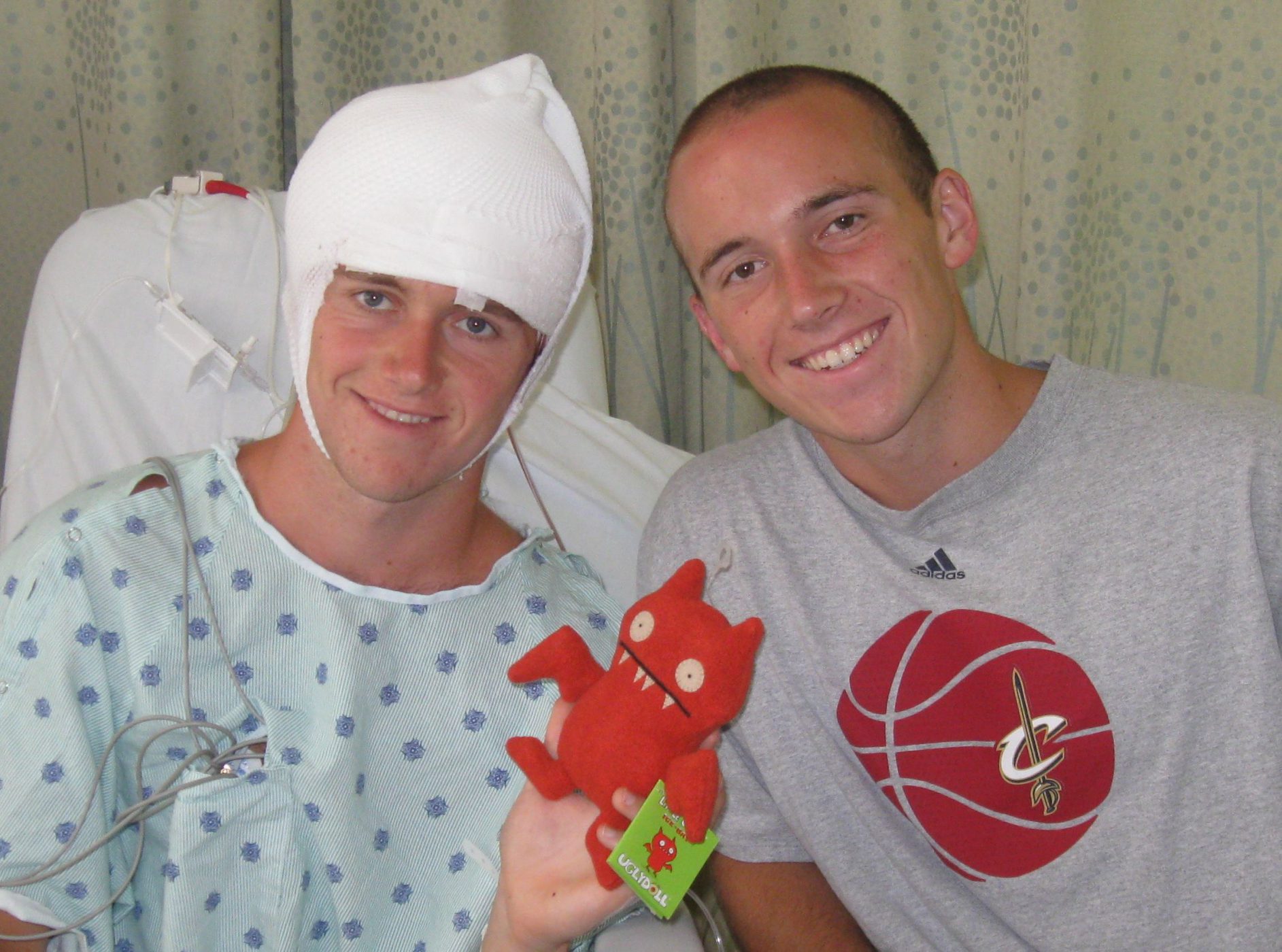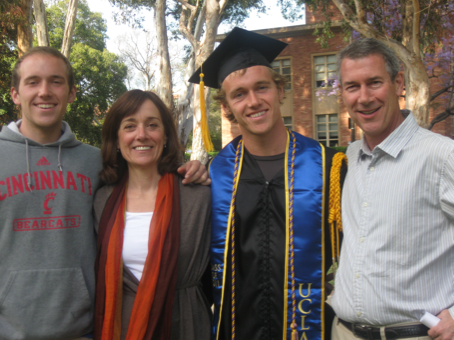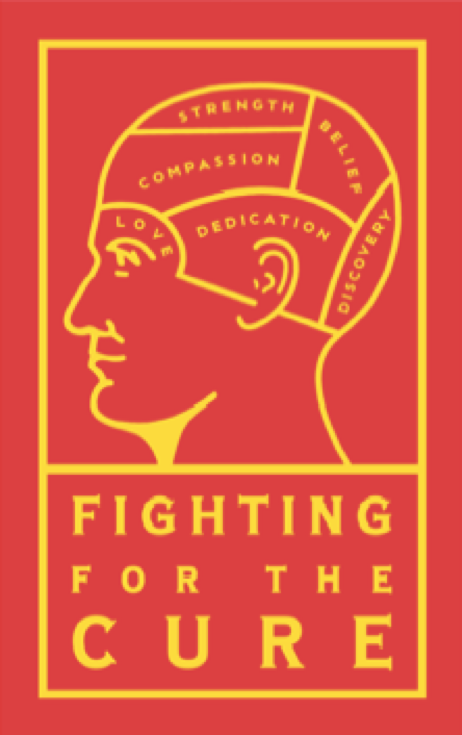The Greene Family Journey
If you or a loved one has been affected by an Oligo, you will recognize parts of our story. Of course, it starts with the shock of the diagnosis. For us it came on August 1st, 2008. Our almost 17-year-old son Spencer had been experiencing focal seizures in his right arm when he played soccer. After three months of eliminating possible causes, an MRI confirmed a brain tumor the size of lemon in his right frontal lobe. We had no idea that a brain tumor was a possibility and knew nothing about them. We were all in shock.
Just days later, Spencer had 8 hours of surgery to remove as much of the tumor as possible—it was pushed up against his motor center, so they had to be cautious. After five days in pediatric intensive care unit, he came home and started his recovery. He returned to school after three weeks, but wasn’t really himself again until the new year. He graduated in June 2009 and deferred college for a year to see what the future would bring. We spent the next 20 months doing the MRI thing, hoping that the tumor would stay
quiet for a long time. In April of 2010, he had another focal seizure which announced that the tumor was still active. In May, he was told he would need to go on chemo for a year.

In June, before Spencer started Temodar treatments, we took a family vacation to Mexico. Our older son, Zach (then 21) joined us there with his girlfriend. A few hours after arriving, we were sitting down to dinner when Zach had a grand mal seizure. Scariest experience of my life! We returned home and the MRI revealed that Zach had a brain tumor as well. During our initial meeting with Zach’s surgeon, he told us that these tumors “always” come back (nice bedside manner!). Fortunately, they were able to remove all of his tumor and he made a miraculously speedy recovery–in three weeks he was back in Los Angeles.
Getting Involved and Learning Some Hard Lessons
For Pam and me, it was impossible to understand how this could happen to both of our children. It was more than I could handle initially, but after a few months, I picked myself up off the floor. I realized that with the most important people in my life at such risk, I was going to have to try to find a way to “save” them.
I started by making a donation to the National Brain Tumor Society (NBTS). A few weeks later I checked out their website and realized they were not funding any Oligo research. Then I checked the other brain tumor foundations—no Oligo research. So, I called NBTS to see what could be done. They told me that they would create a dedicated Oligo research fund…if I would lead the fundraising effort. They also told me that they couldn’t start the research process until we had reached $300,000. Of course, I agreed.
I had never done any fundraising, so I did the most obvious thing: I sent a letter—with an overview of the boys—to family, friends,

and people in my community that I knew at least a little. For two weeks, I didn’t hear from anyone. I started worrying “what if no one responds?” Then I got a message from one of my childhood friends saying he and his wife were donating $10,000. I cried with relief and joy. Overall, the response was amazing, with almost $100,000 being committed.
Over the course of 3+ years, we raised $1.5 million and NBTS made the first two grants in early 2013. Then nothing. With $1M sitting in the bank, NBTS seemed to lose interest (they also had a series of toxic leaders that led to many of the best people leaving). There were a series of incidents that made me realize this was not an organization I could work with or wanted to be associated with. And, most importantly, it was painfully obvious that they were nevergoing to solve our problem.
Why Oligo Nation?
Believe me, it was never our plan to run our own non-profit. After breaking with NBTS, I tried to partner with a huge cancer non-profit, but that led nowhere. So, in early 2014, I jumped in all the way. Oligo Nation was going to have to be the vehicle to deliver the new treatments my family and thousands of others needed.
Early on, I had come to the realization that even if I did everything right in my personal fundraising efforts, it would not get us the kind of funding for research we need. When you multiply any number by 1, it just isn’t very big. It was clear that we needed to be multiplying by 100 or 300 or 500. That was the rationale behind Oligo Nation—getting more of the roughly 20,000 families living with Oligo to join us.
I had also seen how easy—and personally rewarding—fundraising was, so I knew that if we could get other Oligo survivors and their families involved, they would be successful. My experience shows

that most people can raise $5,000 without breaking a sweat. I think for many of us, raising more than that is very do-able. However, doing something new is uncomfortable, maybe even a little scary. So, we want Oligo Nation to be a resource that can help you get started, get advice, and share successes. That’s why we provide ideas, online options, and “how-to’s” and support for different kinds of fundraisers.
The Language of Science
So, fundraising had to be our first priority because without money, there is no research. I had some experience in how this can work from my experience with NBTS and we have continued to expand our efforts here.
Step 2 was investing our funds effectively in research that can make a difference in the next 5 years. Learning what matters, where the opportunities are, the science driving progress, and getting to know key players in the field was a BIG challenge. Probably the steepest learning curve since learning to talk at 2! But it is absolutely indispensable, not to mention exciting and fascinating. Fortunately, the clinicians and researchers in neuro oncology are an incredible group and have welcomed our efforts.
But it took a while to figure things out…Oligo Nation didn’t make its first grant for two years. But we have been very busy since…making twelve research grants in the past two years and advocating at most of the leading brain cancer research institutions.
One of the keys to our approach for advancing research is to operate outside the status quo. We are small, so we have to be smart, opportunistic and persistent to move the needle. Unlike some foundations, we do not measure success by press releases and mentions in medical publications. We are pursuing translational research that if successful can lead to clinical trials in the short-term (2-3 years).
A watershed event was the Oligo Research Summit we hosted in October, 2016 with the support of Dr. Mark Gilbert, head of the National Cancer Institute brain tumor division and Dr. Jeremy Rich, xxx, UC San Diego. We had 19 leading brain cancer researchers work together for two days to share current research as well as identify issues, obstacles, and opportunities.
Paying it Back and Forward
One other area has been of increasing importance to us in the past few years: acting as a resource for others in the Oligo community as they work to navigate a difficult and sometimes confusing landscape of treatment options, second opinions, and insurance hurdles.
My family has received such amazing, ongoing support through the past 10 years that it feels so right to be able to give that support to others in our community. We hope that this new website provides useful information as well.
The Big Short(coming)
The biggest surprise and shortcoming that we have today is that we haven’t been able to reach and enlist the support of many in the Oligo community. I think we felt this would be a “build it and they will come” situation. With limited bandwidth and an array of things to master (research, fundraising, etc), we haven’t done a great job getting the word out…or at least the words haven’t been persuasive enough yetJ.
Like a lot of problems in life, math matters. You multiply any number by 1 (or 12), it’s not that big. Multiply by 100 or 300, that is a different story. To do what we need to do with research, this is where we have to get to. So, we have begun using social media more and are looking for people who can help us get the word out.
There are more and, hopefully, exciting chapters to come for my family and Oligo Nation. I hope that some of you will help us write them.
With love and gratitude,
Brock Greene
[email protected]
May 2018
